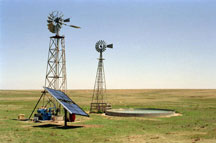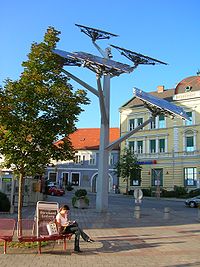Local energy sources that are too small to connect to large-scale
systems.
renewable energy sources, wind power, wind turbines, solar power, solar
cells, solar heating, hyrdopower, micro-hydro, geothermal
power, geothermal heat pump, energy recovery and recycling
While increasing, the use of small decentralized local energy sources to
independently power
individual buildings, products and equipment still has untapped
potential.
Economies of Scale
In principle this pattern is all about scaling energy sources to fit
energy uses.
The terms large and small, centralized and decentralized are relative.
For example, unless wind farms are connected to a national electrical
supergrid they are relatively decentralized.
But a wind farm is larger than a single wind turbine, and they are
still connected as a relatively big centralized system compared to an
individual building.
This pattern addresses the potentials and benefits of the extreme end:
small decentralized energy sources for small decentralized energy uses.
The world's major non-renewable energy sources, oil, coal, natural gas and
nuclear, generally aren't suited as small local energy sources.
While in some ways they have great economies of scale,
they all require considerable processing and refinement to make the
raw materials into usable energy forms.
Few people have coal mines in their back yards where they can pick a shovel
full of coal to power their coal burning furnaces.
You don't fill up your car's gas tank with crude oil, and you don't power a
nuclear plant with raw uranium ore.
Processing these non-renewable energy sources requires a large
industrial infrastructure, which economically requires large volumes
of raw materials, which requires transporting those materials to large
centralized processing facilities.
After processing them in centralized facilities, getting the refined
energy sources to where they are needed requires large, integrated
distribution systems.
In contrast, one or more of the world's major renewable energy resources,
biomass, hydropower, solar, wind and geothermal, are in some form
available almost everywhere, and small sources of these can be used
locally with a minimum of processing and equipment, much less a large
centralized industrial complex to refine the energy itself.

Using wind and solar power to pump water for livestock
Small local renewable energy sources could be tied into large-scale
centralized energy systems, but for various reasons, whether
environmental, technical or economic, this isn't always feasible.
First, small energy sources might be too far from large distribution systems
to make their transport or transmission economically viable.
Second, even if they could be easily connected to a large
distribution system, accommodating many small sources into the system
presents other problems, for example, regulating the intermittent
output of solar and wind power for fluctuating load demands in the
electrical grid.
Rather than tying them into a large energy infrastructure, small local
energy sources are better suited to direct local use as decentralized
stand-alone systems, scaled to power small communities, buildings,
vehicles and devices.
Even where using a small local energy source in a large centralized
system is feasible, many small decentralized uses of that source can
collectively produce a lot of energy, even rivaling the total amount
produced by centralized systems.
For example, instead of a large-scale electric power plant based on
big solar photovoltaic panels, smaller solar panels on individual
buildings, and solar cells on a multitude of devices, could
collectively produce a tremendous amount of electric power.
Using small energy sources everywhere has other advantages.
Since the distribution system for local energy sources is smaller
it takes less energy, materials and money to get the energy where it's
needed.
While waiting for a large centralized facility for a given energy source
to come on line, the contribution of small decentralized energy sources would
be relatively immediate, ramping up over time to equal or exceed the
capacity of that one facility.
Small electrical energy sources, even intermittent ones like wind and solar,
can be networked in small decentralized local "smart grids"
that gradually interconnect to make regional and national smart grids.
Small Biomass Sources
A lot of energy can come from local biomass sources that might otherwise
be discarded and wasted.
A common use of small biomass power is burning wood from trees that have
been cut down or trimmed in fireplaces and Franklin stoves.
Where forests are harvested and wood products are manufactured, wood chips
are another local source.
Where wood is pulped, such as in the production of paper, pulping
liquor or "black liquor" can be burned in recovery boilers.
Other forms of local biomass energy include organic municipal
solid wastes (notably paper), organic manufacturing wastes, scrap
wood materials from construction and demolition, and biogas from
agricultural wastes and landfills.
Small Hydropower
The oldest form of hydropower uses water motion to turn a water wheel,
which turns a shaft to provide mechanical power.
Today large sources of hydropower entail running rivers of water
through huge dams to turn big generators in hyrdoelectric plants.
Large hydroelectric dams aren't practicable where a fast moving stream
is too small, or the land around a large river is too low.
At these hydropower sources many small current generators could produce
a lot of electricity with "micro-hydro" and damless hydroelectric
technology.
Small Solar Sources
In urban areas where there is no open space for a large photovoltaic
power station, putting photovoltaic panels on lots of rooftops and
over parking lots could
be equivalent to, or even bigger than, an humongous solar farm out it
the desert.
Solar photovoltaic cells are increasingly being used to power devices,
from satellites to products such as wrist watches, calculators, garden
lights, street lights, and battery chargers.
We can imagine innovative uses of photovoltaic cells, such as arrays
on top of hybrid-electric buses and trucks to help charge the
batteries and increase range.
In addition to directly producing electricity, another form of small
decentralized solar power is utilizing heat from the sun.
Some big solar plants use mirrors to focus its heat to produce steam to
drive electric generators.
A more common use of solar energy is to use it directly for small space
and water heating, whether actively with solar thermal collectors,
or implementing passive solar building designs.
Small Wind Sources
The oldest forms of wind power include sail boats and wind mills.
Today the biggest form of wind power employs big turbines in wind farms to
produce electricity.
Small wind turbines can be used to generate electricity off-grid
for individual buildings and to power equipment.
When not directly supplying electricity these typically are used to charge
batteries.
Where wind speeds are relatively low a big wind turbine might not work
well, but a whole bunch of little ones could collectively add up to
a lot of power.
Small Geothermal Sources
Large geothermal energy facilities poke deep into the earth's crust
to tap heat to produce steam to turn generators to produce electricity.
But a form of local geothermal power can be used to heat and cool individual
buildings everywhere.
The old fashioned root cellar took advantage of underground temperatures,
which are quite constant throughout the year below the frost line,
roughly the average annual temperature above ground.
Simply putting a building's foundation below the frost line helps
flatten out temperature extremes, reducing energy demands for
heating and cooling throughout the year.
Geothermal heat pumps which circulate air through channels or water
through tubing deep underground can both heat and cool buildings.
A variation of geothermal heat pumps uses cool water deep in wells,
ponds or lakes to cool buildings.
Where the ground is unusually warm, such as near hot springs and
steam vents, the energy can be directly used to heat buildings.
Other Small Energy Sources
There are many other existing and potential ways to use small energy
sources to collectively off-load large centralized systems.
A whole category of examples capture energy that would otherwise be
wasted through energy recovery and recycling.
These examples include recovering waste heat in manufacturing for space
heating and electricity, cogeneration systems that produce both
electricity and heat, and regenerative braking systems in electric
and hybrid-electric vehicles that charge the batteries.
Use small locally available energy sources for temperature control,
such as
Passive Solar Heating and Cooling
and
Geothermal Heating and Cooling
.
Use small locally available energy sources for electric power,
such as
Micro-hydropower
where there are small rivers and streams,
Small Wind Turbines
where it is fairly windy,
and
Small Solar Photovoltaics
to power small communities, individual buildings, vehicles and devices
wherever the sun shines.
Solar Carports
everywhere can help power adjacent buildings and recharge
plug-in electric vehicles while sheltering them from the sun and weather.
Use small sources of energy that might otherwise be wasted with
Energy Recovery and Recycling
such as waste heat recovery,
cogeneration systems that produce both electricity and heat,
and regenerative braking systems
to slow and stop electric and hybrid-electric vehicles.
Use
Small Mechanical Power Sources
like windmills and water wheels to raise water from wells, turn
crankshafts, etc.
. . .


